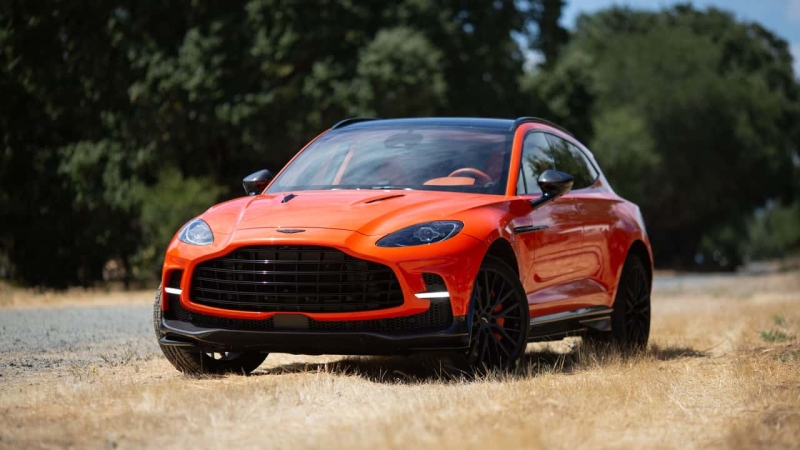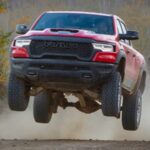An excellent new interior and technical tweaks have delivered on the DBX707’s original promise of a super-SUV.
Photo by: Chris Rosales / Motor1 Chris Rosales  By: Chris Rosales
By: Chris Rosales
- X
Share Comments
A quarter-million-dollar SUV with an Aston Martin badge should be a pretty easy sell these days, what with Bentley’s and Lamborghini’s SUVs moving quicker than the manufacturers can build them.
But the Aston Martin DBX hasn’t been nearly as popular as the Bentayga, Urus, or others in the sporty, ultra-luxe SUV segment, even though Aston’s contender is a gorgeous object with a twin-turbo V-8 making 697 horsepower. It makes you wonder: Why isn’t Aston raking in cash here?
All signs point to the DBX’s interior, which was the central focus of this model-year refresh. An outdated or funky interior is charming in an esoteric sports car or a GT, but less likable in the runabouts of one-percenters. Finally for 2025, though, Aston gave the DBX707 an interior to take the fight to Lamborghini. And it might just be enough to make the DBX the most compelling super-SUV available today.
| Quick Specs | 2025 Aston Martin DBX707 |
| Engine | Twin-Turbocharged 4.0-Liter V-8 |
| Output | 697 Horsepower / 663 Pound-Feet |
| 0-60 MPH | 3.0 Seconds (est.) |
| Weight | 4,940 Pounds |
| Base Price / As Tested | $249,000 / $352,200 |
 Photo by: Chris Rosales / Motor1
Photo by: Chris Rosales / Motor1
Mechanically, the DBX remains largely the same. This SUV still has 697 horsepower and 663 pound-feet of torque. But there was some nipping and tucking of its various systems. Chief engineer Andy Tokley outlined the changes briefly, with most of the updates coming in the air suspension and electronic damper calibration. While no hardware has changed, the equipment is still plenty powerful, especially coupled with active sway bars. Tokley even says that the systems are powerful enough to force the DBX to corner flat, but he values natural feel over the outright domination of physics.
And now, the 707 is the only flavor of DBX available, with the take rate of the base DBX being in the single-digit percentages, according to Aston Martin. The one big change is the interior, which is essentially the same interior introduced on the DB12 and facelifted Vantage. The few of us who got to experience the old Aston interior know that it was at best impractical and at worst confusing, but it had decent leatherwork and quality.
 Photo by: Chris Rosales / Motor1
Photo by: Chris Rosales / Motor1
This new interior offers a complete transformation. Whereas the Bentayga almost feels chintzy and the Urus is dungeonlike by comparison, the DBX707 looks excellent from every angle. The stitched leather is unmatched—even the surfaces tucked into corners of the cabin that otherwise go unused. The overhead handles feel like handmade, lifetime leather products rather than some hard-wearing but unpleasing synthetic. And the user interface—finally, mercifully—is satisfying to use.
The DBX has heavy, metallic, knurl-edged control knobs for every major function. Just switching drive modes using the thunk thunk thunk of the central control knob feels like an event, with an almost offensively heavy control weight. The same goes for the knurled barrels for the HVAC controls, and the new shift lever in place of the nonsensical buttons of the past. It is a wonderful feature that nobody else has.
 Photo by: Chris Rosales / Motor1
Photo by: Chris Rosales / Motor1  Photo by: Chris Rosales / Motor1
Photo by: Chris Rosales / Motor1
The same can’t be said for some of the more conventional controls in the cabin. Aston, inexplicably, put the heated and cooled touch-capacitive controls in high-traffic areas. It’s way too easy to accidentally swipe a seat heater or cooler control on the way to adjusting HVAC or toggling a different damper mode, and it happened several times on a short drive.
Mercifully, the new infotainment is just as good as it is in the Vantage and DB12’s, perhaps even better. The touchscreen responds quickly, though sometimes it gets tripped up and laggy. And I could argue the 10.3-inch central screen feels a hint too small, but it still works well and most of the DBX’s functionality is buttons and knobs rather than screen-based, making a smaller screen a possibility. Yet, those are just ripples in an otherwise extraordinary experience.
 Photo by: Chris Rosales / Motor1
Photo by: Chris Rosales / Motor1
On the road, the cabin is quiet and comfortable, and the ride quality is exceptionally good. Over bumps of any size, there are never any secondary body motions, and the DBX remains resolutely level over consistently bumpy and broken surfaces. Save for true active suspension, what Tokley and his team accomplished is impressive, and the DBX might have the best ride this side of a Cullinan. It’s as though every inch of wheel travel is controlled by the millisecond, and that translates into stable, secure handling.
Sure, the DBX doesn’t really party on a backroad like a Vantage, but it does the job well enough. Handling balance is excellent, and the fundamentals of the all-around dual wishbone suspension and bonded aluminum body shine through. Carving up a small, winding track up a mountain feels athletic and easy, and the scale of the DBX never really catches up despite physics threatening to step in.
 Photo by: Chris Rosales / Motor1
Photo by: Chris Rosales / Motor1
My only complaint is that the steering is number than Linkin Park, but it’s a fair enough concession for a family SUV. It’s just a shame that the Porsche Cayenne can have great steering and not feel tiresome—more automakers could stand to learn this lesson.
Much like the Vantage, the DBX707 really has no more excuses. It is simply an excellent product that can stand on its own, beyond any of the excuses we normally draw up for the Bond brand. The DBX707 is so good that it’s safe to say this: Lamborghini Urus, watch out.
Competitors
- Bentley Bentayga
- Lamborghini Urus
- Porsche Cayenne Turbo GT
- Rolls Royce Cullinan
Get the best news, reviews, columns, and more delivered straight to your inbox, daily. Sign up For more information, read our
Privacy Policy and Terms of Use. Share this Story



